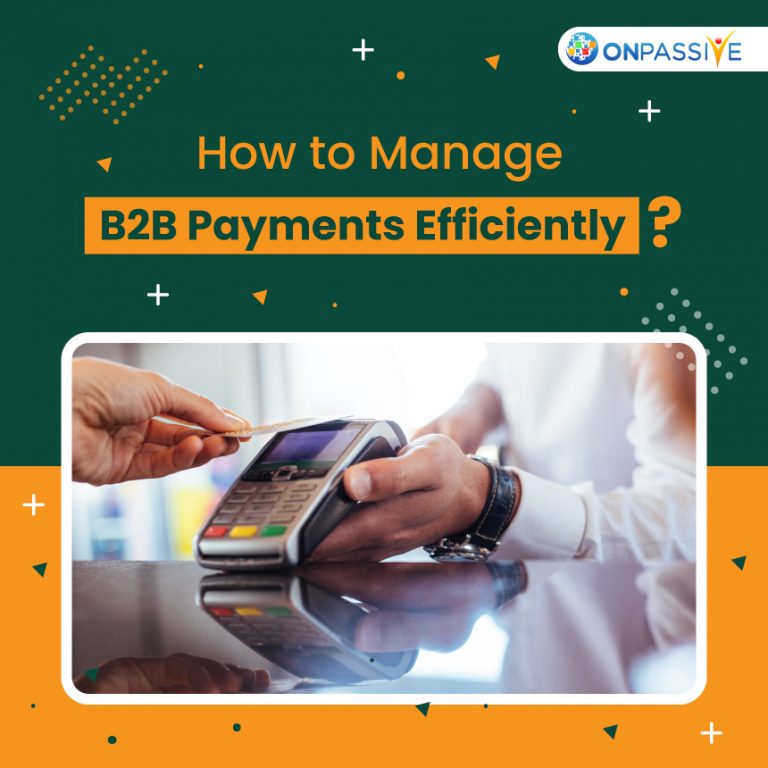
Automation has changed the way modern businesses are conducted and the way Business Payments are made. Electronic money transfers have replaced paper checks, but B2B payments have always been slower to evolve.
Receiving timely payments for their services is always a concern for B2B businesses and managing payments is a key to keep your business growing which ultimately leads you to receive payments on time.
The digital innovations and integration of technologies like Artificial Intelligence (AI) in the payment world have increased digital payment’s importance and made the entire payment process quick and efficient.
Many organizations are now considering integrating powerful technologies with their payment gateways to provide their clients and customers with a seamless payment experience.
ONPASSIVE, an AI-tech company, for instance, has developed the AI-powered digital wallet application “O-Wallet”. ONPASSIVE wallet allows users to make seamless transactions with ease from anywhere while organizing and scheduling their payments.
O-wallet or ONPASSIVE wallet is designed in such a way that it has multiple layers of security and integrated with AI and permits users to store or transfer funds among each other within the ONPASSIVE payment gateway ecosystem.
What are B2B Payments, and How they work?
B2B payments or business to business payments are the payments or transactions made between two companies and differ from other types of payments such as person to person payments (P2P) or business to customer (B2C) payments. However, B2B payments are more complex compared to other types of payments, because of the additional processes involved.
A B2B payment process starts when one business delivers good and services to another business. However, the receiver is sent an invoice and is given a specific time to make the payment. This makes B2B payments a time-consuming process, and in some cases, it takes several days for the payment to be processed, depending on the mode of payment.
However, many B2B companies are now realizing the importance of digital payments. The latest digital payment solutions have enabled a faster flow of cash between the merchants, allowing for quicker B2B transactions.
Tips to effectively manage B2B payments
The following are a few valuable tips to improve your B2B payments efficiently:
Use Online Invoicing
Online invoicing refers to the method of creating and sending invoices through email without printing physical copies. Companies can consider automating their back office for more efficient processing of payments. Confidential documents can also be sent using online invoicing by following up with a secure email link attached to the email.
Electronic B2B billing systems can be used by enterprises of all sizes, while invoices can be created using online accounting software.
Businesses can also streamline the payment processes by integrating AR automation with online invoicing. The main benefits of using online invoicing for B2B payments are faster payments, saving time and money, and improved invoice tracking.
Figure out the costs involved in the Payment Process
Payment processes need to be cost-effective and straightforward. Businesses need to identify how much they are spending on payment gateway integrations and evaluate them in order to minimize the costs involved in the entire payment process.
Initial set-up costs, processing fees and costs related to the payment method are the normal costs involved. However, companies sometimes face other challenges during payment processes such as payout to multiple vendors, split transactions or potential chargebacks.
Therefore, evaluating the costs involved enables companies to understand the costs involved while providing them with opportunities to minimize the costs involved in payment processing.
Use Digital Payment Methods
Digital payment methods are undoubtedly seamless and enable companies to make quick and secure transactions. Many B2B companies are now realizing the importance of digital payments and are integrating new technologies to enable electronic transactions or payments.
Switching to digital payments brings transparency to any transactions and is an instant solution for B2B businesses as they provide immediate confirmations on payments if they are completed or failed.
Therefore, using virtual credit cards, mobile wallets, or third-party financing are great ways to make digital payments for B2B companies.
Provide Different Payment Options
Businesses need to offer their clients and customers with multiple payment options while enabling them to make transactions in different forms. Including digital payment methods along with traditional methods gives an added advantage for companies to make seamless transactions efficiently.
Instant credit, cash on delivery, trade credit, checks, credit card payment, wire transfer, ACH transfer and digital payments are the most commonly used payment methods that most companies offer to their clients or customers.
By integrating the mix of payment, channels enable clients to select their preferred mode of payment.
Conclusion
Payments or transactions need to be managed very efficiently, especially in today’s highly competitive business environment. Therefore, B2B companies need to integrate the latest technologies in their payment methods to provide clients and customers with effective payment solutions to stay ahead in today’s competitive market.
It is imperative to check that your B2B payment solutions are compatible with various payment methods and streamline the entire payment process.



Hafida Selmati
3 years ago
Andrew philip
3 years ago
Surendra Sahoo
3 years ago
G RamaRao
3 years ago